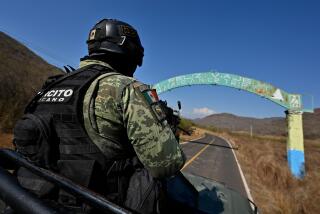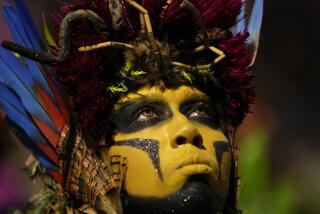Gold Miner Invasion Imperils Stone Age Tribe : Brazil: Officials estimate that 11,000 prospectors have overrun Yanomami land, causing environmental havoc and transmitting deadly diseases.
RIO DE JANEIRO, Brazil — Thousands of gold miners have moved onto the Yanomami Indian reservation in defiance of a government ban, posing the greatest danger so far to the world’s largest Stone Age tribe.
Government officials estimate that 11,000 prospectors have invaded Yanomami land since June, when surveyors finished marking out the reservation in the Amazon rain forest on Brazil’s remote northwestern frontier with Venezuela.
In addition to wreaking environmental havoc, the wildcat miners carry diseases that can be deadly to the 20,000 Yanomami who live on both sides of the border.
“This invasion has been particularly savage,” said Rosane Garcia, a spokeswoman for the government’s National Indian Foundation, known as FUNAI. “The miners are angrier than ever and are reoccupying the area at gunpoint.”
The Yanomami were largely ignored until 1987, when large deposits of gold, diamonds, tin and other minerals were discovered on their land.
Prospectors rushed in, eventually totaling 40,000. Within four years, an estimated 2,000 Yanomami had died in armed clashes and of unfamiliar diseases their systems could not resist.
Under pressure from ecologists to act, the government began “Operation Free Jungle” in 1990. Soldiers and police expelled all but about 150 of the prospectors, destroyed dozens of jungle airstrips and seized tons of mining equipment and aircraft.
Just before the 1992 Earth Summit in Rio, the government created a reservation for the 9,000 Yanomami in Brazil that covers 37,000 square miles, an area larger than Indiana. Venezuela makes no special provisions for the 11,000 on its side of the border.
When public attention had passed on to other things, however, heavily armed miners began moving in, violating a law that bars non-Indians from the reservation. By September, about 5,000 miners were hunting gold on Yanomami land.
With them came a new outbreak of malaria, influenza and tuberculosis, Garcia, the FUNAI spokeswoman, said in a telephone interview from Brasilia, the capital.
Helicopter patrols and warnings from federal police are no longer enough to chase miners from Indian villages.
“From the air, you can see them cutting large tracts of forest for airstrips and firewood,” Garcia said. “The gold dredges are back and the miners are dumping mercury in streams, killing the fish and making it impossible for the Yanomami to find drinking water.”
The government announced that “Operation Free Jungle II,” to drive the miners out again, would begin.
Dr. Giovanini Coelho, National Health Foundation director for Roraima state, said 1,000 miners with shotguns and rifles had invaded several villages in the Catrimani region in the heart of the reserve.
They raided the nearby Homoxi health clinic for food and threatened to kill the clinic’s seven staff members unless they left, he said.
On Jan. 22, the medics were taken out by helicopter. The next day, several hundred state troopers ambushed the miners at the Homoxi outpost and arrested 225 after a brief gun battle. Coelho said most fled into the jungle.
Air force helicopters flew the prisoners to Boa Vista, the state capital 300 miles to the northeast.
“It’s a guerrilla war and the Yanomami are caught in the cross-fire,” Coelho said.
Disease has proved even more deadly.
Up to 80% of the Yanomami in Brazil have malaria, according to the Health Foundation. The disease killed 160 Yanomami in 1992, officials said, most of them in the last half of the year.
In 1991, the year of the previous high, malaria claimed 104 Yanomami.
Luis Pinheiro Borges, head of a special Yanomami health task force, said venereal and skin diseases were spreading rapidly.
“A diarrhea epidemic, something we hadn’t seen for a year, has started and it’s leading to widespread malnutrition,” he said. “In many cases, we can’t get to the sick because the jungle has become a shooting gallery.”
A team of eight doctors is preparing to return to Catrimani with the support of the international volunteer group Doctors Without Borders, Borges said.
Defenders of Indian rights claim that Gov. Ottomar Pinto and other politicians in Roraima state have encouraged prospectors to return to their old mining camps on Yanomami land.
There are reports that Pinto, who favors assimilating the Yanomami and opening their land to mineral exploitation, has broadcast messages on a Boa Vista radio station telling prospectors to ignore the federal ban.
“Basically, Pinto gave the miners a call to arms,” said Carlo Zaquini by telephone from the state capital. Zaquini, a Roman Catholic priest and Indian rights activist, has spent 28 years with the Yanomami.
After the prospectors were expelled in 1990, many moved to new mining sites in Venezuela and Guyana, across the largely unmonitored jungle borders.
In Venezuela, the army went after them, shooting down a plane and killing two miners. Many other Brazilian gold-seekers have been arrested and deported.
More to Read
Sign up for Essential California
The most important California stories and recommendations in your inbox every morning.
You may occasionally receive promotional content from the Los Angeles Times.










